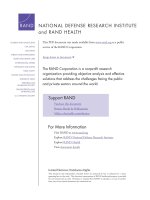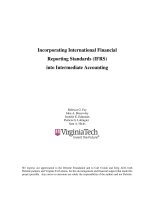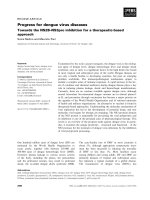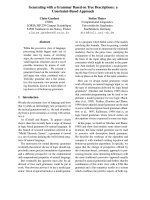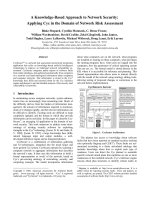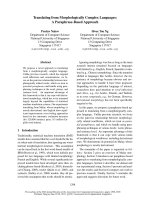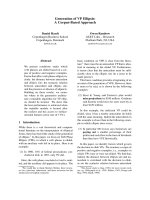Financial reporting under IFRS a topic based approach by wolfgang dick and franck missonier piera
Bạn đang xem bản rút gọn của tài liệu. Xem và tải ngay bản đầy đủ của tài liệu tại đây (11.34 MB, 360 trang )
To download more slides, ebooks, solution manual, and test bank, visit
To download more slides, ebooks, solution manual, and test bank, visit
To download more slides, ebooks, solution manual, and test bank, visit
WILEY
Financial Reporting
under IFRS
To download more slides, ebooks, solution manual, and test bank, visit
To download more slides, ebooks, solution manual, and test bank, visit
WILEY
Financial
Reporting
under IFRS
A Topic Based Approach
Wolfgang Dick
Franck Missonier-Piera
A John Wiley and Sons, Ltd., Publication
To download more slides, ebooks, solution manual, and test bank, visit
This edition first published 2010
C 2010 John Wiley & Sons, Ltd
Registered office
John Wiley & Sons Ltd, The Atrium, Southern Gate, Chichester, West Sussex, PO19 8SQ, United
Kingdom
For details of our global editorial offices, for customer services and for information about how to apply
for permission to reuse the copyright material in this book please see our website at www.wiley.com.
The right of the author to be identified as the author of this work has been asserted in accordance with
the Copyright, Designs and Patents Act 1988.
All rights reserved. No part of this publication may be reproduced, stored in a retrieval system, or
transmitted, in any form or by any means, electronic, mechanical, photocopying, recording or
otherwise, except as permitted by the UK Copyright, Designs and Patents Act 1988, without the prior
permission of the publisher.
Wiley also publishes its books in a variety of electronic formats. Some content that appears in print
may not be available in electronic books.
Designations used by companies to distinguish their products are often claimed as trademarks. All
brand names and product names used in this book are trade names, service marks, trademarks or
registered trademarks of their respective owners. The publisher is not associated with any product or
vendor mentioned in this book. This publication is designed to provide accurate and authoritative
information in regard to the subject matter covered. It is sold on the understanding that the publisher is
not engaged in rendering professional services. If professional advice or other expert assistance is
required, the services of a competent professional should be sought.
Library of Congress Cataloging-in-Publication Data
Dick, Wolfgang, 1965–
Franck, Missonier-Piera, 1968-Financial reporting under IFRS : a topic based approach / Wolfgang
Dick, Franck Missonier-Piera.
p. cm. – (Wiley regulatory reporting ; 1)
Includes bibliographical references and index.
ISBN 978-0-470-68831-1 (pbk.)
1. Financial statements. 2. Accounting–Standards. 3. International finance.
I. Missonier-Piera, Franck. II. Title.
HF5681.B2D515 2010
657 .3–dc22
2010021933
A catalogue record for this book is available from the British Library.
ISBN 978-0-470-68831-1 (paperback), ISBN 978-0-470-97385-1 (ebk),
ISBN 978-0-470-97162-8 (ebk), ISBN 978-0-470-97161-1 (ebk)
Typeset in 10/11pt Times-Roman by Aptara Inc., New Delhi, India
Printed in Great Britain by Antony Rowe Ltd, Chippenham, Wiltshire
To download more slides, ebooks, solution manual, and test bank, visit
CONTENTS
Chapter
1
2
3
4
5
6
7
8
9
10
Title
Foreword
Introduction
Acknowledgements
Financial Statements and Accounting Mechanisms . . . . . . . . . . . . . . . . .
Income from Ordinary Activities . . . . . . . . . . . . . . . . . . . . . . . . . . . . . . . . .
Current Assets . . . . . . . . . . . . . . . . . . . . . . . . . . . . . . . . . . . . . . . . . . . . . . . . . .
Non-financial Liabilities . . . . . . . . . . . . . . . . . . . . . . . . . . . . . . . . . . . . . . . . .
Non-current Assets . . . . . . . . . . . . . . . . . . . . . . . . . . . . . . . . . . . . . . . . . . . . . .
Financing . . . . . . . . . . . . . . . . . . . . . . . . . . . . . . . . . . . . . . . . . . . . . . . . . . . . . .
Taxation . . . . . . . . . . . . . . . . . . . . . . . . . . . . . . . . . . . . . . . . . . . . . . . . . . . . . . .
Group Accounts . . . . . . . . . . . . . . . . . . . . . . . . . . . . . . . . . . . . . . . . . . . . . . . .
Financial Analysis and Communication . . . . . . . . . . . . . . . . . . . . . . . . . . .
The IASB and Development of the IFRS . . . . . . . . . . . . . . . . . . . . . . . . . .
Index
Page
No.
vii
ix
xiii
1
37
65
97
125
163
189
215
261
313
327
To download more slides, ebooks, solution manual, and test bank, visit
To download more slides, ebooks, solution manual, and test bank, visit
FOREWORD
This textbook is the outcome of collective thinking and the experience of professors from
several institutions. Accountability and responsibility for this book lie with Wolfgang Dick
and Franck Missonier-Piera. Wolfgang Dick is a Professor at the ESSEC Business School
(France) and co-holder of the ESSEC-KPMG Chair in Financial Reporting. The interests
of Wolfgang Dick relate to accounting harmonization, IFRS, intangible assets and corporate
governance. Franck Missonier-Piera is a Professor at the University of Geneva (Switzerland).
His interests relate to IFRS, corporate governance, financial analysis and accounting for
financial instruments.
A French version of the book has been developed with the cooperation of the following
colleagues. Corinne Bessieux–Ollier, Professor of Accounting at Montpellier Business School
(France). Roger Dinasquet, Professor of Accounting at the ESSEC Business School. Bernard
Esnault, Professor of Accounting at the ESSEC Business School. Jean-Luc Rossignol, Senior
Lecturer at the University of Franche-Comt´e (France) and Peter Walton, Professor at the
ESSEC Business School and the Open University (UK).
To download more slides, ebooks, solution manual, and test bank, visit
To download more slides, ebooks, solution manual, and test bank, visit
INTRODUCTION
The European Commission now requires companies in the European Union (EU) which use
public savings to present their accounts according to the standards of the IASB (Interna
tional Accounting Standards Board). This has implications for a majority of them. Until 2004,
companies listed in the EU could use national accounting standards. For example, in France,
consolidated financial statements had been prepared in accordance with rule CRC 99-02. This
rule now applies only to the consolidated accounts of non-listed groups. The introduction of the
standards of the IASB, i.e. IFRS (International Financial Reporting Standards), has imposed
a major change in the presentation of accounts. The accounting and finance departments of
listed companies, as well as all users of financial statements, should be able to understand the
principles of the IFRS. This book therefore refers to international rather than national account
ing standards. For the various actors of the economy, harmonization of rules of measurement
and presentation of financial statements will facilitate comparison of the financial situation
and performance of firms across different countries. However, before presenting the principles
of preparation and presentation of accounting information, one should understand the role of
that information and the objectives of the IASB.
1.
USERS OF FINANCIAL AND ACCOUNTING INFORMATION
The financial statements meet the information needs of many users, who are:
� Current and potential investors (shareholders). Early users of financial informa
�
�
�
�
�
�
tion, they are concerned by the risk inherent in their investment and its profitability.
They seek information to determine if they should buy, hold or sell shares in a par
ticular company. Shareholders also want to estimate the company’s ability to pay
dividends.
Creditors. The information they seek is to enable them to determine whether their loans
and interest related thereto will be paid at maturity dates.
Suppliers. The information they seek is to enable them to determine if the amounts that
are due will be paid at maturity.
Customers. They seek information on business continuity, especially when they have
long-term relationships with the firm (i.e. the supplier).
Employees and their representatives. They seek information on the stability and conti
nuity of the operations of the company that employs them. They are also concerned by
the profitability of the company, reflecting its ability to pay employees, provide benefits
on retirement and employment opportunities.
States and their agencies. They care about including the allocation of resources gener
ated by businesses. They thus determine the appropriate tax policies based on national
income statistics (for example). It is therefore necessary to impose disclosure require
ments.
The public. They are interested in the firm’s activities, because it contributes substan
tially to the local economy, including employing a large staff or using local suppliers.
The financial statements can inform them of trends and recent changes to the company’s
prosperity and the extent of its activities.
To download more slides, ebooks, solution manual, and test bank, visit
x
Financial Reporting under IFRS
2.
THE ROLE OF ACCOUNTING INFORMATION
The many users of financial statements have specific information needs. The financial state
ments serve two main functions – not mutually exclusive – and thus meet the needs of most
users:
� An informational role. Numerous users need to estimate the value of a company. Thus,
when evaluating, potential investors (insurance companies, investment companies, pen
sion funds, etc.), financial analysts and other market participants are concerned both
with the results of the company and its future performance. Accounting earnings are
one of the variables used by investors. Similarly, the estimated cost of credit depends
in part on the financial health of the company. Thus, incurring excessive debt and poor
earnings may affect the granting of new loans. From the simple evaluation of the fi
nancial position of a firm wishing to borrow from a bank to the complex system of
assessment of rating agencies (e.g. Standard & Poor’s, Moody’s), performance, lever
age and solvency ratios are at the heart of the assessment process of capital suppliers.
They are based on accounting data published by the company.
� A contractual role. Accounting data can also help to control the proper execution of
contracts between the firm and its business partners. Special contracts govern the rela
tionship between the firm and its stakeholders (e.g. creditors, suppliers, staff, company
management, etc.). The contracts of the firm based on accounting data are contingent on
the peculiarities of each company. For example, the employment contracts of executives
link some of their compensation to performance indicators (return on equity, return on
assets, etc.) to encourage them to maximize the value of the firm. Loan agreements
may include specific covenants to protect the interest of creditors. For example, the
contract may limit the level of debt (measured with accounting data) and may restrict
the payment of dividends.
The financial statements do not meet all information needs of users. However, these latter have
common needs. Investors are providers of risk capital to the entity, and the IASB considers
that when the financial statements satisfy the needs of investors, they also satisfy most users.
3.
OBJECTIVES OF THE IASB
To meet the needs of shareholders and investors regarding financial and accounting informa
tion, the IASB has three objectives of standardization, in its preface to the IFRS:
� To develop, in the public interest, a single set of global standards, understandable and
applicable, that must provide information of high quality, transparent and comparable
with regards to financial statements and other accounting data. This helps users of
information, including those involved in capital markets, to make economic decisions.
� To promote the use and rigorous application of these standards.
� To work actively with the standard setters in different countries to bring about con
vergence of accounting standards in different countries with IFRS, in order to obtain
high-quality solutions.
The Framework for the Preparation and the Presentation of Financial Statements of the IASB
presents in greater detail the objectives of financial statements, their qualitative characteristics
and their components. In theory, when decisions on standards are taken, the IASB should
To download more slides, ebooks, solution manual, and test bank, visit
Introduction
xi
ensure compliance with the framework, which states that the objective of financial statements
is to provide information on the financial position, performance and change in the financial
position of an entity that is useful to a wide range of users in making economic decisions.
The economic decisions taken by users of financial statements require evaluation of a com
pany’s capabilities to generate cash and cash equivalent, and their maturity or the assurance of
their realization. The financial position of a company is affected by the economic resources it
controls, its financial structure, liquidity and solvency and its ability to adapt to environmental
changes.
Structure Plan
The financial statements are crucial in decision making and should reflect the resources that
the company controls. Components of financial statements are explained in terms of assets and
liabilities. The balance sheet shows the assets and liabilities of the company, and the difference
represents the residual interest of the shareholders.
Chapter 1 (“Financial Statements and Accounting Mechanisms”) presents the structure and
mechanisms of preparation of financial statements. Chapter 2 (“Income from Ordinary Activi
ties”) addresses the company’s performance, measured by the difference between the revenues
and expenses of the company for a given period. Revenues and expenses are in a financial
statement: the income statement (Profit or Loss account). Revenues come from an increase in
assets or a decrease in liabilities. As for expenses, they come from a decrease in assets or an
increase in liabilities. Any designer of accounting rules has to decide whether to start from the
income statement when making measurements (i.e. by looking at the commercial transactions)
and then consider the balance sheet as a remainder, or to start from the balance sheet (i.e. what
wealth the company has generated and what are its obligations) with changes in the balance
sheet items expressed within the income statement.
Chapters 3 (“Current Assets”) and 5 (“Non-current Assets”) handle the assets used for business
operations. They generate a number of obligations towards suppliers when goods or raw
materials are purchased on credit and towards the employees in terms of compensation, but
also pension contributions (Chapter 4, “Non-financial Liabilities”).
Chapter 6 (“Financing”) presents the main financial obligations, for example vis-`a-vis credit
institutions. Chapter 7 (“Taxation”) deals purely with fiscal obligations. The presentation of
financial statements of a group of companies requires specific accounting treatments, presented
in Chapter 8 (“Group Accounts”).
Chapter 9 (“Financial Analysis and Communication”) analyzes all of the information provided
both from the perspective of credit risk and profitability for shareholders.
Finally, Chapter 10 (“The IASB and Development of the IFRS”) reviews the history of the
IASB and the continuous process of developing future international standards.
To download more slides, ebooks, solution manual, and test bank, visit
To download more slides, ebooks, solution manual, and test bank, visit
ACKNOWLEDGEMENTS
We wish to thank the companies that have allowed this book to be richly illustrated and thus
promote the understanding of the complex topic that is the IFRS. These are Accor, Arcelor
Mittal, AstraZeneca, Bic, BP France, British Airways, Cap G´emini, Club Med, Danone,
Deutsche Telekom, Fiat, Lafarge, L’Or´eal, LVMH, PSA Peugeot-Citro¨en, Publicis, Renault,
Rolls Royce, Schneider Electric, Suez Environnement, Total, TUI, Unibail Rodamco, Unilever,
Vinci, Vodafone and Volkswagen.
We also wish to thank Thomas Dumoulin, Vincent Ferry, Thomas Gaimard, Rachel Gorney,
Stefan Jensen and Kanchan Rabadia for their help in copy editing the chapters, J´er´emy Borot
for his valuable contribution in drafting the exercises, and Guillaume Pech and Fanny Sergent
for managing relationships with the quoted companies.
This book has received the financial support of the ESSEC Research Center, the ESSEC-KPMG
Chair in Financial Reporting, and the EMLyon CERA Chair in Growth firm.
To download more slides, ebooks, solution manual, and test bank, visit
To download more slides, ebooks, solution manual, and test bank, visit
1
FINANCIAL STATEMENTS AND
ACCOUNTING MECHANISMS
Financial disclosure has become a critical function for businesses. Today, firms are under
pressure from various stakeholders (financial markets, the State, clients, employees, etc.) and
are therefore engaged in information policies, in order to meet changing requirements. Thus,
we can see that annual reports are providing a growing supply of information. It covers not
only the needs of corporate governance, through the establishment of a management report
and description of the principal organs of corporate control (for example, the structure of the
Board and capital, the firm’s Audit committee, the salaries, etc.), but also those related to
the firm’s environmental responsibility. Other documents and summary tables – the financial
statements – also provide various business partners with a wide range of information about
the nature and performance of the firm’s activity. They perform various functions. On the
one hand, they can serve as evidence or control tools for monitoring the performance of
contracts between the firm and its partners. On the other hand, they provide investors and
other users with relevant information for economic decision making. Financial statements are
therefore supposed to better reflect the economic situation of the company so that investors
can properly evaluate the performance (section 1.1). In order to produce useful and relevant
information, the preparation of financial statements is based on a number of principles, uses
its own mechanisms of information processing (section 1.2) and allows a rigorous synthesis.
1.1 FINANCIAL STATEMENTS
The objective of financial statements is to inform all stakeholders about the business situation
at a given date. We can identify several groups of regular users of financial statements. The
current or potential owners of the company (shareholders for limited liability companies) are
the first to be concerned by the financial statements. They are interested in the performance of
the company in order to measure the profitability of their investment. On a long-term basis, it
is also useful to know the evolution of business investments in order to evaluate if the company
will be able to generate profits in the future, and therefore to distribute dividends. For similar
reasons, the management team is also concerned by the information contained in the financial
statements. Indeed, shareholders have delegated the management of their capital invested to
them. Financial statements therefore provide a means for controlling the financial performance
of the management team, by informing the owners of the quality of their decisions. In that
matter, financial analysts are an important group of users. Their objective is to assess the
company as a whole and to make recommendations on whether to invest in it or not. Many
banks and other current and potential investors use the recommendations of these experts for
decision-making purposes. Thus, the company must necessarily “supply” them with the most
complete information possible. Although analysts do not exclusively base their decision on
the financial statements, the latter represent a fundamental element of their analysis.
Other users of financial statements are the bankers, suppliers and other creditors who wish to
know whether the company is – and will be – able to meet its financial commitments. This is
related to both the reimbursement of debts and the payment of interest on loans. Moreover,
To download more slides, ebooks, solution manual, and test bank, visit
2
Financial Reporting under IFRS
the State, local authorities and social organizations refer to the accounting records to calculate
the contributions and corporate taxes payable by the company. Finally, employees and their
representatives also need information on the situation of the firm. It allows them to determine
the outlooks on job security and define their social demands.
All these groups of users need information, in near real time, on the financial situation,
performance and the status of the company’s cash account.
The financial situation consists in identifying the assets used by the company (lands, buildings,
machinery, vehicles, inventory, receivables, and cash) and the financial resources, evaluating them
and analyzing the evolution of their value over time.
The financial situation consists, at first, in identifying the assets used by the company (for
example, lands, buildings, machinery, vehicles, inventory, receivables and cash), evaluating
them and analyzing the evolution of their value over time. Meanwhile, the evolution of the
financial resources, which enabled the acquisition of those assets, must also be carefully
monitored. For instance, the more the company gets into debt, the more difficult it will be to
reimburse its debts. Even a slight increase in debt can have significant consequences on the
business, when a bank decides that it has crossed a particular risk threshold and, accordingly,
increases the interest rate for all future loans.
The performance or the net income shows whether the activity of the firm as a whole is profitable,
which is normally the main objective of the management team.
The performance or the net income shows whether the activity of the firm as a whole is
profitable, which is normally the main objective of the management team. Here, “profitability”
means that the money invested by the owners can make profits and thus increase their wealth.
Entrusted by the owners to achieve this objective at any cost, the management of the company
has to follow the change in income, using the financial statements, to ensure that the decisions
are in accordance with the target fixed by the owners. If this is not the case, the regular
monitoring of income enables corrective measures to be taken, before the situation of the
company deteriorates.
The cash account includes cash, bank deposits and a number of other monetary elements which the
company could liquidate within a very short span of time, usually in less than 3 months.
The cash account includes cash, bank deposits and a number of other monetary elements
which the company could liquidate within a very short span of time, usually in less than
3 months. The objective here is different from the profit, that is to say it is not to maximize
it.1 However, it is important to have enough cash at all times, to meet financial deadlines, i.e.
1
For example, too much liquidity in bank accounts which generates little or no interest, could mean that
the management of the company has borrowed too much from banks or asked too much capital from its
To download more slides, ebooks, solution manual, and test bank, visit
Chapter 1 / Financial Statements and Accounting Mechanisms
3
reimburse loans, pay the invoices of suppliers, salaries and taxes, etc. Failure to meet financial
deadlines and the inability of the company to meet its commitments may result in insolvency,
or even the outright liquidation of the company shortly afterwords. The analysis of the status
and evolution of cash flow is therefore of high importance for the survival of the company.
Under the international accounting standards (IAS/IFRS), it is compulsory to publish at least
one table dedicated to the analysis of each of these elements. Sections 1.1.1 to 1.1.3 explain
the content and format of these tables, as well as the relationships between them.
1.1.1
Balance Sheet
Content
The balance sheet is the basic summary table, which presents the financial situation of a company
at a given date.
The balance sheet is the basic summary table. It presents the financial situation of a company
at a given date. It is measured by the difference between all assets of the company and all
its liabilities (obligations to do, to pay) and represents the net value of what belongs to the
owners, the “shareholders’ equity”. The balance sheet therefore presents three main elements:
assets, liabilities (or obligations) of the company and its shareholders’ equity.
An asset is an item, a resource controlled by the firm from which future economic benefits are
expected. It has a positive value for the company.
An asset is a resource (controlled by the firm) from which the company expects future economic
benefits and has a positive value for it.2 The future economic benefit is the potential of the
asset to contribute directly or indirectly to cash flows for the benefit of the company. The assets
of the balance sheet are primarily the “properties” of the company, i.e. what the company is
at a given date in purely “physical” terms. It included lands, buildings, industrial equipment,
furniture, inventory and cash. There are also intangible assets: either rights (patents or licenses,
for example), or financial assets (equity investments, receivables, short-term investments or
bank deposits).
A liability is an obligation to do or to pay. It has a negative value for the company.
Liabilities are obligations to do or to pay. They have a negative value for the company, since,
at maturity, the company will have to reimburse them to third parties. It includes mainly bank
2
owners, and does not know what to do with this excess cash. This can be the sign of mismanagement.
However, this analysis would be different if this was done in preparation for the takeover of a
competitor.
Under certain conditions, some items are also included in the assets of the company, even if they do
not belong to it (see Chapter 6).
To download more slides, ebooks, solution manual, and test bank, visit
4
Financial Reporting under IFRS
loans and overdrafts, accounts payables and tax liabilities. We can add other liabilities whose
exact timings or amounts are not known, but their existence is sure and certain, such as pension
obligations, long-term product warranties or provisions for legal risks.
The shareholders’ equity is the difference between assets and liabilities. It represents the net value
of the firm.
The difference between assets and liabilities results in the shareholders’ equity. It is the net
value of a firm: it represents the value of what owners possess at the time of the establishment
of the balance sheet. In normal circumstances, this value must at least include the subscribed
capital. It is the initial input of owners, i.e. the capital invested at the creation of the company
and the contributions made during each capital increase. Inasmuch as the profits over time
are not fully paid as dividends, we should also find the part not distributed under “equity
reserves”.
The net income is the balance between creation and consumption of wealth over a period
(revenues – expenses).
The shareholders’ equity is also affected by each consumption (expense) or creation of wealth
(revenue) in the company. The balance between creation and consumption of wealth over a
period is the net income (Revenues – Expenses = net Income). If it is positive, the net creation
of wealth returns to the owners and the value of their investment increases: this is known as
a profit. If negative, it is the opposite: the value of the investment declines and is known as a
loss. The net income is therefore the basic indicator of wealth creation for the company.
Format IAS 1 standard does not impose any compulsory detailed format of presentation. It
rather indicates some principles to follow:
� The separate presentation of assets, liabilities and shareholders’ equity.
� The distinction between current and non-current assets and current and long-term
liabilities. In practice, the threshold is usually of one year: elements with a residual
maturity in the company of less than one year are considered to be current items, others
as non-current.
� The distinction, among others, between:
– lands, buildings and equipments
– intangible assets, such as licenses, patents, software
– financial assets
– inventory
– receivables
– cash and equivalents
– accounts payables
– provisions for contingencies, i.e. those obligations whose exact timings and amounts
are not yet known
To download more slides, ebooks, solution manual, and test bank, visit
Chapter 1 / Financial Statements and Accounting Mechanisms
5
Non Current Assets
+
Current Assets
-
Non Current Liabilities
-
Current Liabilities
=
Shareholders’ Equity
Figure 1.1 Balance sheet structure: “Anglo-Saxon” format.
– financial debts (especially bonds and bank loans)
– shareholders’ equity, including the initial input by the owner (equity capital), the
non-distributed income (reserves) and the net income/loss of the accounting period.
� The possibility of a finer classification, if it improves the understanding of the financial
situation of the company.
� The presentation of values for at least one comparative year, which allows the reader to
compare current values with those of the previous accounting period.
For the actual presentation of the balance sheet, several alternatives are generally used. The
choice depends mainly on the accounting tradition of the country in which the company
operates (e.g. UK, France, Germany, etc.).
The Anglo-Saxon tradition presents the balance sheet in a list format, which has for “resultant”
the shareholders’ equity at the bottom of the table. This balance sheet first indicates the assets,
from which it deducts the obligations or liabilities. This leads to a balance (Net Assets), which
represents the net value of the firm, and corresponds to the value of the shareholders’ equity
(see Figure 1.1).
In the consolidated balance sheet3 of BP (British Petroleum) at 12/31/2008 (see Figure 1.2),
the amount of Non-Current Assets of $161,854m is clearly distinguished from that of the
Current Assets of $66,384m. The total assets are therefore of $228,238m. After deduction of
3
When a standalone company presents its balance sheet, we speak of an individual balance sheet. The
same company can be part of a group of several subsidiaries. The group’s financial situation as a
whole is presented in the “consolidated balance sheet” (see Chapter 7).
To download more slides, ebooks, solution manual, and test bank, visit
6
Financial Reporting under IFRS
Figure 1.2 Extract of the BP annual report 2007, values in millions of dollars.
Liabilities of $136,129m, the Net Assets amount to $92,109m. This represents the total Equity
presented on the bottom line. In the UK, Current Assets and Current Liabilities are generally
grouped together, as is the case in this example where they amount to $69,793m. We can thus
easily calculate an indicator that measures the Net Current Liabilities of $3,409m (69,793 −
66,384). Bonds maturing in the short term are thus more than covered by liquid assets in the
same time frame. This is an important indicator of financial stability in the short term.
According to French tradition, which is also that of most countries of continental Europe,
goods and assets possessed by the company are presented in the Assets section, on one side
of the balance sheet, and obligations and equity are grouped under the Liabilities section, on
To download more slides, ebooks, solution manual, and test bank, visit
Chapter 1 / Financial Statements and Accounting Mechanisms
Assets
7
Liabilities & SE
Shareholders’ Equity
Non Current Assets
Non Current Liabilities
Current Assets
Current Liabilities
Figure 1.3 Balance sheet structure, French format.
the other side of the balance sheet. The Liabilities therefore represent all funds invested in the
company, whether on a limited (debt and provisions) or unlimited period (equity). The Assets
represent the form in which financial resources are invested and employed in the business. Of
course, it is not always possible to create a direct link between a given resource and a specific
application. But originally, any asset had to be financed in one way or another and there was
therefore a liability of corresponding value. That is why Total Assets and Total Liabilities are
always for the same amount (see Figure 1.3).
In the French balance sheets, the term “Liability” covers two different meanings, which can
be confusing. In the meaning mentioned above, “Liability” refers to all the financial resources
available to the entity. But “Liabilities” can also designate the obligations of the entity to third
parties, whether they are current or non-current. For this reason, the concept does not include
equity. These two meanings can be used simultaneously by the same entity in the same balance
sheet, as illustrated by the annual balance sheet of Lafarge Group in 2007 (see Figure 1.4).
In Figure 1.4, we can easily identify the basic structure of the balance sheet: Assets at the top
and Liabilities below. The two major categories of Assets are Non-current Assets (€21,490m)
and Current Assets (€6,818m), giving Total Assets of €28,308m at 12/31/2007. The liability
is structured into three sections: first, equity, here called “Shareholders’ equity” (€12,077m),
then non-current obligations under the designation “Non-current Liabilities” (€10,720m) and
current obligations, under the heading “Current Liabilities” (€5,511m). The bottom line of the
balance sheet entitled “Total Liabilities” includes both current and non-current liabilities and
shareholders’ equity (€28,208m).
Like that of BP in the previous example, this presentation enables one to observe easily, for
example, whether the values achievable in the short term (€6,818m) are sufficient to cover
short-term obligations (€5,511m). The situation of Lafarge seems entirely satisfactory, since
there is a surplus (€1,307m).
To download more slides, ebooks, solution manual, and test bank, visit
8
Financial Reporting under IFRS
Consolidated balance sheets
At December 31
2007
(million euros)
2006*
2005*
ASSETS
Non current assets
21,490
20,474
20,543
Goodwill
Intangible assets
Property, plant and equipment
Investments in associates
Other financial assets
Derivative instruments – assets
Deferred income tax asset
7,471
472
11,904
331
1,096
5
211
7,511
426
11,183
253
830
70
201
6,646
355
12,171
376
626
49
320
Current assets
6,818
9,367
7,352
Inventories
Trade receivables
Other receivables
Derivative instruments – assets
Cash and cash equivalents
Assets classified as held for sale
1,761
2,515
1,061
52
1,429
-
1,619
2,674
1,126
60
1,155
2,733
1,857
2,737
925
98
1,735
-
28,308
29,841
27,895
Common stock
Additional paid-in capital
Treasury shares
Retained earnings
Other reserves
Foreign currency translation
Shareholders’equity – parent company
Minority interests
691
6,019
(55)
4,411
36
(104)
10,998
1,079
707
6,420
(72)
3,023
31
205
10,314
1,380
704
6,316
(98)
2,025
(37)
741
9,651
2,533
Equity
12,077
11,694
12,184
Non current liabilities
10,720
11,962
9,852
Deferred income tax liability
Pension & other employee benefits liabilities
Provisions
Long-term debt
Derivative instruments – liabilities
695
724
928
8,347
26
529
1,057
935
9,421
20
515
1,415
984
6,928
10
Current liabilities
5,511
6,185
5,859
Pension & other employee benefits liabilities, current portion
Provisions, current portion
Trade payables
Other payables
Income tax payable
Short term debt and current portion of long-term debt
Derivative instruments – liabilities
Liabilities directly associated with assets classified as held
for sale
79
201
1,732
1,553
148
1,762
36
-
120
132
1,598
1,668
136
1,664
25
842
156
123
1,675
1,575
165
2,077
88
-
28,308
29,841
27,895
Total Assets
Equity & Liabilities
Total equity and liabilities
* Figures have been adjusted after the application by the Group of IAS 19, Employee Benefits, allowing the recognition
through equity of the actuarial gains and losses under defined-benefit pension plans
Figure 1.4 Extract of the Lafarge, Balance Sheet, annual report, 2007.
To download more slides, ebooks, solution manual, and test bank, visit
Chapter 1 / Financial Statements and Accounting Mechanisms
9
The current/non-current approach goes as far as to separate, a priori, within a single homoge
neous element, the short-term and the long-term parts. Thus, in the balance sheet of Lafarge,
we find in both Non-Current and Current Liabilities, the line “Financial Liabilities”, which
essentially refers to the financial debt of the group. The part of this debt that matures within one
year is allocated to Current Liabilities (€1,762m) and the part that matures in more than one
year to Non-Current Liabilities (€8,347m). Reading financial statements therefore requires
great vigilance. Most terms are not mandatory and companies can choose others.
1.1.2
Income Statement (or Profit and Loss Account)
One of the two areas of the balance sheet that deserves a very special attention is the change
in equity between two fiscal periods. They may increase or decrease as a result of specific
operations, such as increases or reductions of capital. The issuance of new shares is an example
of a capital increase in a public company. The net income has also an impact on the change in
equity. It reflects the amount of net creation or consumption of wealth of the company by its
activity or other events between two fiscal periods. It measures the economic performance of
the company. All users of financial statements need maximum information on the composition
of the result. The second summary table, the profit and loss account (or income statement),
gives details about the different elements of expenses and revenues.
A revenue is an operation that increases the wealth of the company.
An expense is a consumption of resources that impoverishes the company.
According to their call to make the connection between two balance sheets, therefore between
two closing dates, the values in the income statement represent only the flows recorded over
the period. A transaction that increases the wealth of the company is called a revenue and
the consumption of resources that impoverishes the company is an expense. For example, the
revenue that is generally the most important, i.e. the turnover, is not the turnover of the closing
date, but the one achieved during the period to which the income statement refers. It is the
same for all other revenues and expenses.
The exact content of the income statement is not completely detailed. In all cases, according
to the IAS 1 standard, the requirements are to include:
� Financial expenses, representing the cost of financing the entity.
� Revenues from ordinary activities, that is to say, sales and all other revenues that the
entity realized in the framework of its activity.
� Income tax.
� Net income of the accounting period.
� Net earnings per share in two variants.4
Thus, in the income statement, there is no requirement to give the details of expenses related
to the activity. However, the standard strongly recommends that details be provided for one of
the following classifications:
4
Chapter 8 describes the two types of earnings per share.

